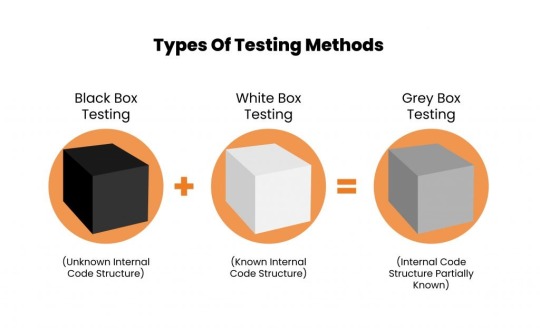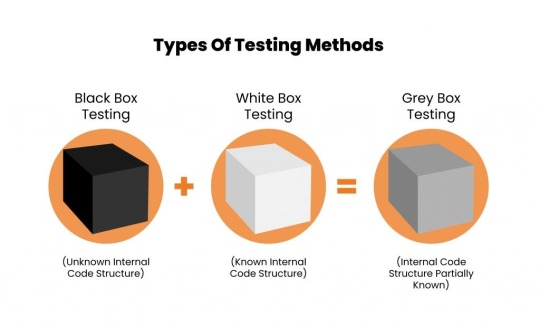#black box testing
Explore tagged Tumblr posts
Text
Concinnity
It was mizzle in the afternoon, when the discussion was on going and afterwards activity was handed out. It was ludic, so emerge to it that we don't notice the time again. Very productive, hoping for more engaging activities. Code is sure a lot of work to do and testing to make sure the product will satisfy the client.

1 note
·
View note
Text
#Performance Testing#Security Testing#Load Testing#Software Optimization#Application Security#QA Performance#Cybersecurity Testing#Stress Testing#Mobile App Testing#Android Testing#iOS App Testing#Cross-Device Testing#Mobile QA#Mobile Automation Testing#App Performance Testing#Real Device Testing#Functional Testing#Software QA#Feature Validation#System Testing#Manual Testing#Automated Functional Testing#End-to-End Testing#Black Box Testing#ETL Testing#Data Validation#Data Warehouse Testing#BI Testing#Database QA#Data Quality Checks
0 notes
Text
Exploring Black Box Testing: Techniques, Pros, and Cons

If you’ve ever wondered how software applications get tested without delving into their code, you’re thinking of black box testing. In software engineering, this type of testing evaluates the functionality of an application without examining its internal workings
But how do testers approach Black box testing in practice? Let’s look at some proven techniques.
How to use black box testing?
Boundary value analysis: It focuses on edge cases, such as maximum and minimum input values.
Equivalence partitioning: It divides input data into invalid and valid sets for efficient testing.
State transition testing: This tests how software behaves when it is transitioning between states.
Decision table testing: It maps inputs and expected outputs in complex scenarios.
Error guessing: It is based on the tester’s past knowledge and intuition to discover bugs in the system.
What are the types of testing under black box testing
But where do we use these black box testing techniques? Here’s a look at their types and practical uses in testing.
Functional testing: This checks what the application does. Think of it as testing buttons on a laptop work or if the login screen is doing what it is supposed to. For example, whether you can log in with the right username and password, whether the ‘reset password’ field works or what happens if you forget your password. Retesting an application is done to ensure that if something that was broken, it is now fixed.
Non-functional testing: This checks how the application performs. It’s like testing how strong or fast something is. Here are some smaller types of non-functional testing:
Performance testing: This tests how well the application works. Can it handle a lot of users at the same time?
Accessibility testing: Is it easy for people with disabilities to use it (like hearing or vision impairments)?
Usability testing: Is the app easy to use and can it be used without instructions?
Security testing: Is your personal data safe with the app? Can someone hack into your system?
Regression testing: This makes sure that new changes in the application don’t interfere with the old stuff.
Knowing the types of black box testing demonstrates its breadth, but what about the benefits of black box testing?
What are the benefits of black box testing?
Black box testing brings several advantages to software testing.
It simplifies the process by focusing more on the output rather than the code.
It enhances the overall software development quality by focusing on end-user scenarios.
Automation testing can help speed up repetitive tasks, improving efficiency and identifying the cost of fixing bugs later.
No process is perfect, and black box testing is no exception. Here are some hurdles to consider.
What are the problems with black box testing
Limited scope: Testers can lose edge cases without access to the code and understanding of the business domain.
Test case dependency: There is a dependency on well-defined test cases since continuous evaluations of the test cases are necessary to make sure that there is comprehensive coverage.
The pesticide paradox: Running the same tests repeatedly can lead the software to adapt to the defects. To avoid this, testers need to regularly diversify and update their test cases including new techniques and scenarios.
Thankfully, automation tools help testers to cover the execution of the repetitive scenarios and focus on identifying Edge Cases, exploratory testing
Automation and black box testing
Incorporating automation tools into black box testing can significantly improve efficiency. Automated testing scripts are invaluable for performance testing or running regression suites.
Black box testing is an integral part of software development services, offering an end user-centric perspective to ensure performance and functionality. By using robust testing techniques and automation testing, software developers can create software that’s scalable, reliable and ready for modern users. Visit Nitor Infotech to learn more about our software development services.
#app development#application development#web application#software for apps#software development#it software development#user testing#black box testing
0 notes
Text
What is Black Box Testing? AComprehensive guide

What is Black Box Testing
Black box testing is a software testing method that focuses on verifying the functionality of an application without examining its internal structures or workings. Testers treat the software as a "black box," only interacting with its inputs and observing its outputs, without knowing or accessing the code behind it. This approach is critical in ensuring that the software behaves as expected from the user’s perspective, focusing on the external features rather than the underlying logic.
How Black Box Testing Works
In black box testing, the tester focuses on inputs and outputs, evaluating whether the software behaves as expected based on given requirements. The tester provides input data, interacts with the system, and observes the resulting outputs without needing knowledge of the software's internal code structure. The primary goal is to confirm that the software meets functional and non-functional requirements by simulating real-world scenarios users may encounter.
For example, a tester might enter login credentials into a web application, click the "login" button, and check whether they are successfully logged in without delving into how the authentication process works internally.
Types of Black Box Testing Techniques
There are several key techniques used in black box testing to ensure comprehensive coverage of the software's functionality:
Equivalence Partitioning: This technique divides input data into equivalent partitions or classes, where all inputs in a partition are expected to yield the same results. The tester only selects one representative input from each partition, reducing the number of test cases while maintaining coverage.
Boundary Value Analysis: This focuses on testing the boundaries of input ranges. For instance, if a form field accepts values between 1 and 100, the tester would evaluate inputs at the edge values like 1, 100, 0, and 101, where errors are most likely to occur.
Decision Table Testing: Decision tables help represent combinations of inputs and their corresponding outcomes, providing a clear and structured way to ensure all possible conditions and scenarios are tested.
State Transition Testing: This technique is used to test systems that change their behavior based on current and past inputs or states. Testers verify that the system transitions correctly between different states and that each transition behaves as expected.
Black Box Testing vs. White Box Testing
While black box testing focuses on external functionality, white box testing examines the internal workings and code structure of an application. In white box testing, the tester has access to the source code, enabling them to check how different code paths are executed and whether certain conditions are met.
Black Box Testing: Emphasizes the user perspective and ensures the software functions as per requirements. It’s used to validate functionality without digging into code implementation details.
White Box Testing: Focuses on code structure and logic, helping to identify code-level issues such as dead code, incorrect loops, and logical errors.
Both black box and white box testing have their own strengths, and many testing strategies involve a combination of both to ensure full coverage.
Advantages of Black Box Testing
Black box testing offers several advantages, particularly when it comes to validating the user experience and functionality of the software:
No Need for Code Knowledge: Testers do not require any knowledge of the underlying code, making it accessible to both technical and non-technical testers. This allows a wider range of people to participate in testing, including QA engineers and product owners.
Early Testing: Black box testing can be performed as soon as functional specifications are available, allowing testers to validate features early in the development cycle.
Functional and Non-Functional Testing: Black box testing can validate both functional aspects (e.g., whether a button works) and non-functional ones (e.g., performance, usability).
Focus on User Experience: This approach simulates real-world use cases, ensuring that the software behaves as expected from a user’s perspective.
Limitations of Black Box Testing
Despite its benefits, black box testing also has some limitations that testers need to be aware of:
Lack of Internal Knowledge: Since testers don’t have access to the code, they may miss issues related to the internal structure, such as unexecuted code paths or logic errors.
Incomplete Test Coverage: Without insight into the code, some edge cases might be overlooked, particularly those involving internal states or complex logic.
Difficulty Tracing Root Causes: When a test fails, it can be difficult to determine the exact cause of the issue, as black box testing only highlights the symptoms, not the source.
When to Use Black Box Testing in the Software Development Lifecycle
Black box testing can be applied at various stages of the software development lifecycle, making it a versatile method for ensuring software quality:
Unit Testing: While traditionally associated with white box testing, some black box techniques can be applied to individual units or components by verifying input and output behavior.
Integration Testing: Black box testing is used to verify that different components of a system work together as expected, without focusing on the internal communication between components.
System Testing: This is where black box testing shines, as it is used to validate the entire system’s functionality against the specified requirements.
Acceptance Testing: Black box testing plays a crucial role in user acceptance testing (UAT), where end-users validate that the system meets their expectations and requirements.
Tools for Black Box Testing
There are several tools that can assist testers in performing effective black box testing, from automated test case generation to issue tracking. Popular tools include:
Selenium: Widely used for automated web application testing, Selenium allows testers to create scripts that simulate user interactions with a browser.
QTP (QuickTest Professional): A comprehensive tool for functional and regression testing, QTP supports keyword-driven testing and integrates well with other tools in the test automation ecosystem.
TestComplete: A versatile tool that supports both functional and unit testing, offering features for GUI and non-GUI testing across different platforms.
Each tool has its strengths, and the choice depends on factors such as the type of application being tested and the team’s familiarity with the tool.
Best Practices for Effective Black Box Testing
To get the most out of black box testing, it’s important to follow best practices that ensure thorough testing and accurate results:
Clearly Define Expected Outcomes: A solid understanding of the software’s requirements and expected outcomes is essential for effective black box testing. Ensure that test cases are based on well-defined functional specifications.
Use a Combination of Techniques: Employing different black box testing techniques, such as boundary value analysis and equivalence partitioning, helps improve test coverage and identify edge cases.
Regularly Update Test Cases: As software evolves, requirements and functionalities change. Keep test cases up to date to ensure they continue to reflect the current state of the application.
Conclusion: The Importance of Black Box Testing
Black box testing plays a crucial role in validating the external behavior of software applications, ensuring that they meet user expectations and business requirements. It’s an essential part of any comprehensive testing strategy, offering a user-focused approach that can catch functional errors early and validate both functional and non-functional aspects of the system.
While it has limitations, black box testing, when combined with white box testing, provides thorough test coverage and ensures that both the user experience and internal quality are maintained. By integrating black box testing into your testing strategy, you can improve software reliability and deliver a better product to users.
0 notes
Text
QA & SOFTWARE TESTING - Spark Technologies
We design, develop, implement, manage and optimize access to systems and information to answer your business processing, application and infrastructure needs. Whether you are a private or public sector organization, or whether you want to run our solutions on your own hardware, or outsource your IT through us, Spark Technologies has the expertise you need to overcome the business challenges you face.

#functional testing#automation testing#compatibility testing#ui testing#load testing services#usability testing#cross-platform testing#performance testing services#integration testing#black box testing
1 note
·
View note
Text
Kiểm thử hộp đen (Black box testing)
Kỹ thuật kiểm thử hộp đen (Black-box testing) là một phương pháp kiểm thử phần mềm, trong đó người kiểm thử không cần biết về cấu trúc bên trong hoặc mã nguồn của ứng dụng. Thay vào đó, họ tập trung vào việc kiểm tra chức năng của hệ thống dựa trên các yêu cầu và đặc tả. Mục tiêu chính của kiểm thử hộp đen là xác định xem hệ thống có đáp ứng đúng các yêu cầu và hoạt động chính xác trong mọi tình…

View On WordPress
0 notes
Text
Black Box Testing in Software Engineering

With our state-of-the-art training program, you will be able to become an expert in Software Engineering's Black Box Testing. Explore the complexities of software testing techniques in depth to become an expert tester who can guarantee the performance and dependability of any software product. Under the guidance of professionals in the field, our extensive program covers all the bases, from basic ideas to sophisticated methods, giving you the edge you need to succeed in the cutthroat world of IT today. Enroll at Croma Campus to begin your journey toward a fulfilling career in software testing, an industry where skill and accuracy are critical.
0 notes
Text
Stop Bugs in Their Tracks: Functional Testing Services Are Your Secret Weapon

In the rapidly advancing field of technology, bugs in software can provide a significant obstacle to achievement. The effects of defective software are severe and might range from unpleasant user experiences to monetary losses. Functional testing services act as a secret weapon that can be used to tackle these flaws. Let's explore the benefits of functional testing services, different testing approaches, choosing the best vendor, and the continuous significance of testing that is free of errors.
For more information, read https://gunaworks.medium.com/stop-bugs-in-their-tracks-functional-testing-services-are-your-secret-weapon-8ef07774a084
#functional testing#functional testing services#white box testing#black box testing#software#software development#software design#software testing#agiledevelopment#agileprojectmanagement#development
0 notes
Text
This blog discusses Black Box testing in detail, including types, tools, features, approaches, test cases and processes, techniques, SDLC integration, and advantages and downsides. It also compares Black Box testing to White Box testing.
0 notes
Text
https://www.edu-art.in/exploring-black-box-testing-benefits/
Black box testing checks how software works without looking inside. It focuses on what the application does, not how it does it.. As a tester, you evaluate the application as a “black box” – unable to see inside, only able to interact through inputs and outputs. In this post, we will explore the key benefits that black box testing provides and why it remains an important part of the software testing process, if you are looking for Software Testing Course in Mumbai where you can learn all the Testing Methods.
#success#studying#teaching#institute#software#software testing#course#software testing course in thane#software testing in mumbai#black box testing#blog
0 notes
Text
Embark on an enlightening journey into the world of Black-Box Penetration Testing. 🔍🌐
Uncover the techniques and strategies that keep systems secure.
1 note
·
View note
Note
hey so I know you said art for personal use is okay but i was curious as to if you would be okay with me printing out your art 😭 i need things on my walls in my dorm and ive been obsessed with your unique magic series since you posted them lol. totally ok if not!
oh yeah, that's absolutely fine, thank you! ❤️❤️❤️ and if you're after the UM posters specifically, I put up higher-res versions of them here so they should print pretty nicely! :>
#in the ensuing saga of me not understanding printing: how much could a printer need? 30000 ppi?#typing numbers into the little document boxes in photoshop and pretending i know what i'm doing#i had initially also wanted to do color correction but then i actually looked into it and that's all. like.#dependent on the software + printer + paper + the phase of the moon probably#so Always Do Test Prints First™#very generally speaking i think it looks best with the paper (and printer if able) settings set to premium/presentation paper#and on the highest quality setting it has#honestly when i found out you can change the paper settings my life changed...#the first time i printed something that had actual saturation it about blew my mind#me watching rich black come out of my printer: holy
195 notes
·
View notes
Text

The Black Manta.
Now available for purchase on INPRNT
#box#racer#track#champion#test#speed#cyberpunk#android#femalecharacter#cyborg#race#black#manta#machinehead#machine#engine#cables#electricity#hoko#brand#illustration#digitalillustration#digitaldrawing#digotalart#retro#scifi#scan#90s
213 notes
·
View notes
Text
Black Box Testing: A Comprehensive Guide

Black box testing is a crucial aspect of software quality assurance, focusing on the functionality of an application without delving into its internal code structure. This method simulates how end-users interact with a software application, ensuring that it behaves as expected from an external perspective.
Understanding Black Box Testing
Black box testing is characterized by its focus on external behavior and its independence from internal code. It involves testing the application's inputs, outputs, and functionality without examining the underlying code. This approach allows testers to focus on the overall user experience and identify any issues that may affect the application's usability.
Types of Black Box Testing
There are various types of black box testing techniques, each with its own specific approach:
Equivalence Partitioning: This technique divides the input data into equivalent classes and selects test cases from each class.
Boundary Value Analysis: This technique focuses on testing values at the boundaries of input ranges.
Decision Table Testing: This technique is used to test complex decision-making logic within the application.
State Transition Testing: This technique is suitable for applications with different states or modes of operation.
Use Case Testing: This technique involves testing the application's functionality based on user scenarios or use cases.
Advantages of Black Box Testing
Black box testing offers several advantages in ensuring software quality:
Independence: It is independent of the internal code structure, making it suitable for teams with different skill sets.
Efficiency: It can be efficient for large and complex applications.
User-Centric: It focuses on the user's perspective, ensuring that the application meets their needs.
Early Detection: It can help identify defects early in the development process.
Disadvantages of Black Box Testing
While black box testing is valuable, it has limitations:
Limited Coverage: It may not cover all possible execution paths within the application.
Dependency on Specifications: It relies on accurate and complete specifications.
Time-Consuming: Creating comprehensive test cases can be time-consuming.
Best Practices for Black Box Testing
To maximize the effectiveness of black box testing, it's essential to follow certain best practices:
Clear Requirements: Ensure that the requirements for the application are well-defined and understood.
Test Case Design: Develop comprehensive test cases that cover various scenarios and use cases.
Prioritization: Prioritize test cases based on their importance and risk.
Test Automation: Consider automating repetitive test cases to improve efficiency.
Continuous Testing: Integrate black box testing into the development process to ensure early defect detection.
Tools for Black Box Testing
A variety of tools can aid in black box testing, automating tasks and improving efficiency:
Test Management Tools: Tools like JIRA and TestRail can help manage test cases, track defects, and generate reports.
Automation Tools: Tools like Selenium and Appium can automate web and mobile application testing.
Performance Testing Tools: Tools like JMeter and LoadRunner can assess the application's performance under load.
Conclusion
Black box testing plays a vital role in software development, ensuring that applications meet user expectations and function as intended. By following best practices and utilizing appropriate tools, organizations can effectively implement black box testing to enhance software quality and deliver reliable products.
0 notes
Text
how would tommylizzie function under the warder bond...
#black tower asha'man and camp follower he bonded to save his life / protect her in a spiral. not aes sedai and warder#while tommy joins the black tower undercover on behalf of some churchill-esque party who is acting crossways to aes sedai dysfunction#originally thought he'd just be undercover in the dragonsworn only to test positive to be trained and had to roll with it#recruited by mazrim taim and exposed to the dark one#protected from the taint but tainted by what he's done to gain the protection. as it were#bond w lizzie is a singular grey thread through the black#alfie as a complete wildcard in loghain's camp is also a necessity#idle wot x peaky blinders mashup thoughts#the only wot fanfic that keeps nagging at me is that insider view of the black tower politics#because everything else is so engrossed in the series but the black tower is an absolute black box. we know what goes in and what comes out#but not what goes on#hence why i think that asha'man POV is the only one that has nagged at me over the last 15-20 years of the series
5 notes
·
View notes
Text
making heinously bad decisions rn*
*bleaching my hair to try and dye it like miss lana del rey from this era


#everyone pray for me#quickly!#did i do a test strand? no.#am i putting this bleach over years of black box dye? yes!
52 notes
·
View notes